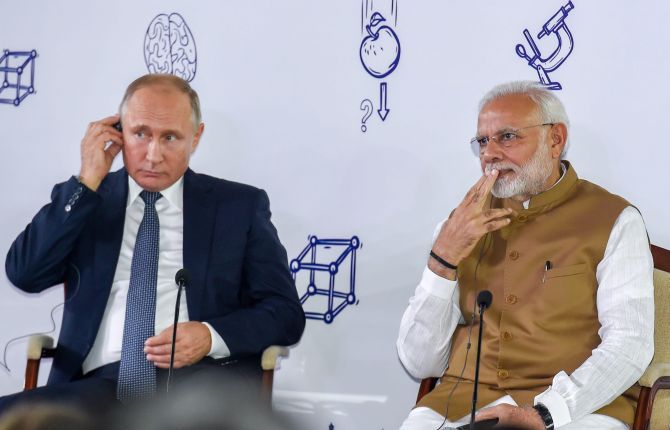Putin's last-minute intervention with PM salvages $5.43 bn pact.
Ajai Shukla reports.

The low-key announcement on Friday, October 5, of India's $5.43 billion purchase of Russia's S-400 air defence missile system contrasted sharply with the flourish with which Prime Minister Narendra Damodardas Modi and then French president Francois Hollande announced the April 2015 agreement to supply India 36 Rafale fighters.
Meeting the press in New Delhi, Modi and Russian President Vladimir Putin avoided any mention of the S-400 during their comments to the media. Nor did the contract feature in an official Ministry of External Affairs list of documents signed.
Eventually, India's biggest overseas arms contract since the Rafale buy found official mention only through one brief sentence in the Indo-Russian joint statement, released by the MEA.
The joint statement noted: 'The sides (New Delhi and Moscow) welcomed the conclusion of the contract for the supply of the S-400 long-range surface-to-air missile system to India.'
I learnt it was not wrangling over the price that clouded the deal with uncertainty. Instead, top Indian government officials disagreed on whether to risk US ire by concluding a deal that Washington has made clear it disapproves of.
Sources close to the negotiations said while Defence Minister Nirmala Sitharman has consistently backed the S-400 purchase, National Security Advisor Ajit Doval -- who is more alert to the US signalling -- wanted to postpone signing the contract.
On his visit to Washington in mid-September, Doval met top US officials, including Secretary of State Mike Pompeo, Defence Secretary James Mattis and his American counterpart, John Bolton.
They are understood to have warned him that India's purchase of the S-400 might trigger US sanctions under the Countering America's Adversaries Through Sanctions Act, CAATSA.
CAATSA binds the US administration to impose sanctions against countries that engage in 'significant transactions' with Russian, Iranian and North Korean defence and intelligence entities.
To exempt close partners such as India and Vietnam, the US Congress has legislated a waiver that the US president can invoke.
However, Doval was told there is no guarantee that President Donald Trump would invoke the waiver for India.
Two days after returning from the US, Doval received a top-level delegation from Rosoboronexport, Moscow's defence exports agency, to tie up details of defence contracts to be signed during the Modi-Putin summit.
Doval expressed his strong reservations about signing the S-400 contract, given the 'current climate' -- an apparent reference to the Rafale controversy, but which could have also meant pressure from Washington.
In the days leading up to Putin's visit, Moscow remained in touch with Doval's office to tie up the visit agenda.
The NSA steadfastly maintained that neither the S-400 deal, nor the deal for four Krivak III-class frigates, would be signed during Putin's visit.
As late as Thursday, when Putin landed in New Delhi, the Russian side was told that no defence agreements would be signed during the summit.
However, Putin raised the subject with Modi, both on Thursday night and in the Friday talks.
"Eventually, it was Modi who took the call on Friday morning to go ahead with the S-400 contract," says an individual close to the decision-making.
Even so, the announcement was done without flourish. "It is hard to say whether the government is more worried about blowback from the US Congress, or from the Indian National Congress," quipped a senior civil servant.
According to Russian language technical papers published by designers of the S-400, it is designed primarily as an air defence system with only limited capability to shoot down ballistic missiles.
The designers of the S-400 Triumf (NATO designation SA-21 Growler) say it is built to shoot down aircraft at low and very low altitudes, even when stealth technology greatly reduced their target signatures.
Its ability to track multiple targets caters for a crowded airspace with large numbers of aircraft, as well as drones.
It is designed to defeat advanced electronic jammers and survive on a battlefield where the enemy is targeting the S-400 with precision-guided munitions.
The capability to engage tactical ballistic missiles and intermediate range ballistic missiles -- the anti-ballistic missile role -- is mentioned at the end, almost as an afterthought.
Even though the first S-400 units might be deployed to protect Delhi -- its long range allows it to cover the area up to the Indo-Pakistan border from deployment areas in the National Capital Territory -- its primary mission will remain anti-aircraft protection.
Guarding Delhi from ballistic missile attack will be the job of an ABM system the Defence Research & Development Organisation is currently developing and testing.
While the S-400 will be paid for from the air force budget, its vehicle-mounted configuration allows it to provide air defence cover to the army's mechanised strike corps. It can also be fitted onto capital warships such as the Aegis system, which guards US Navy warships.











